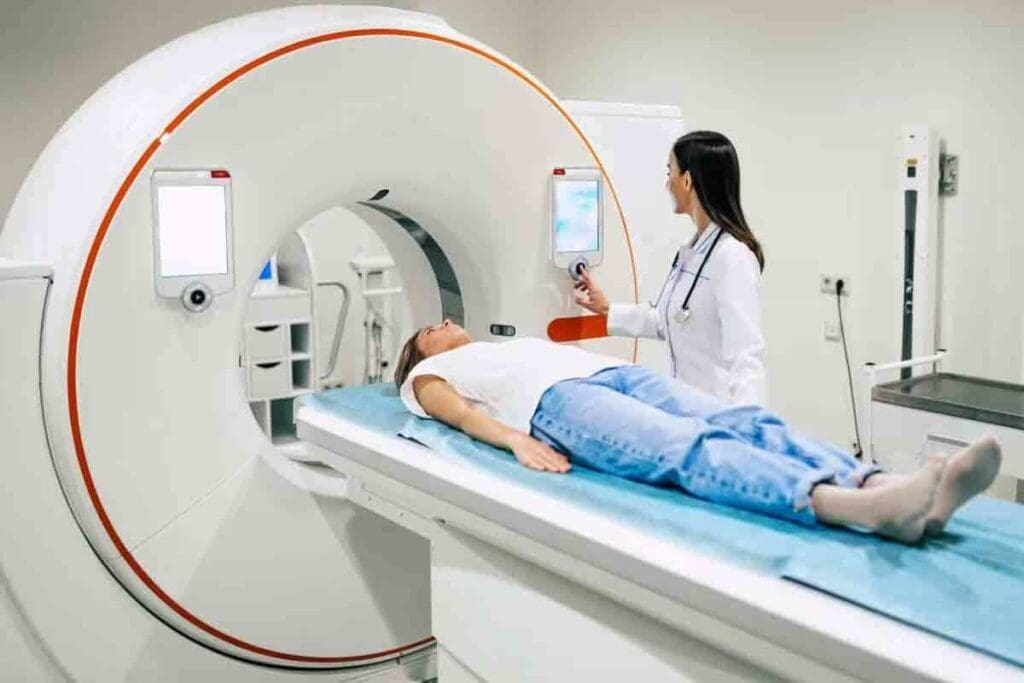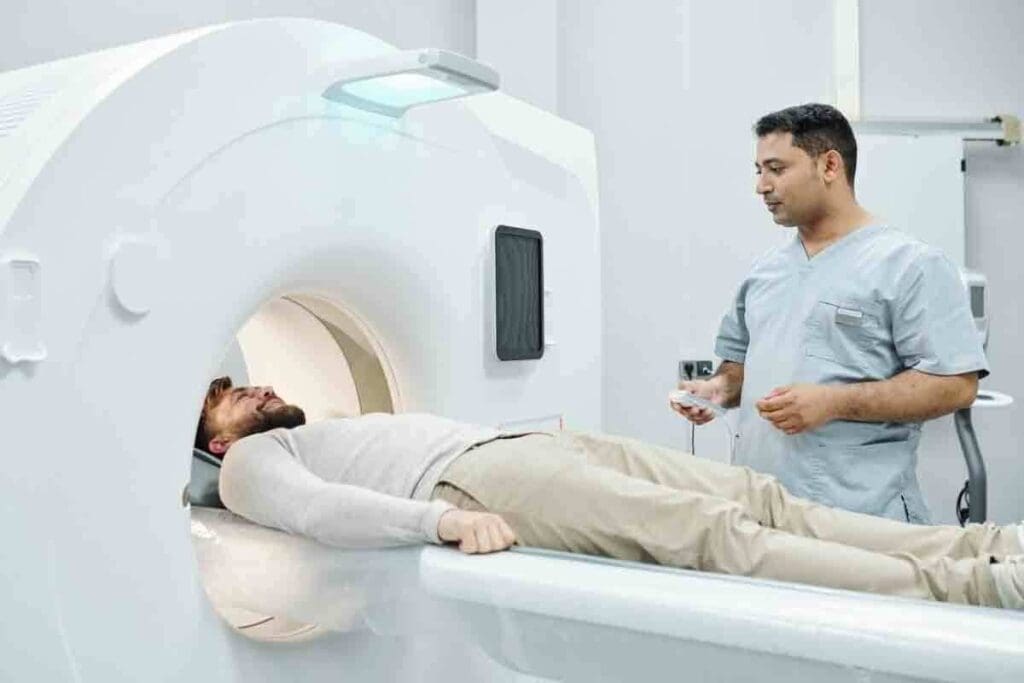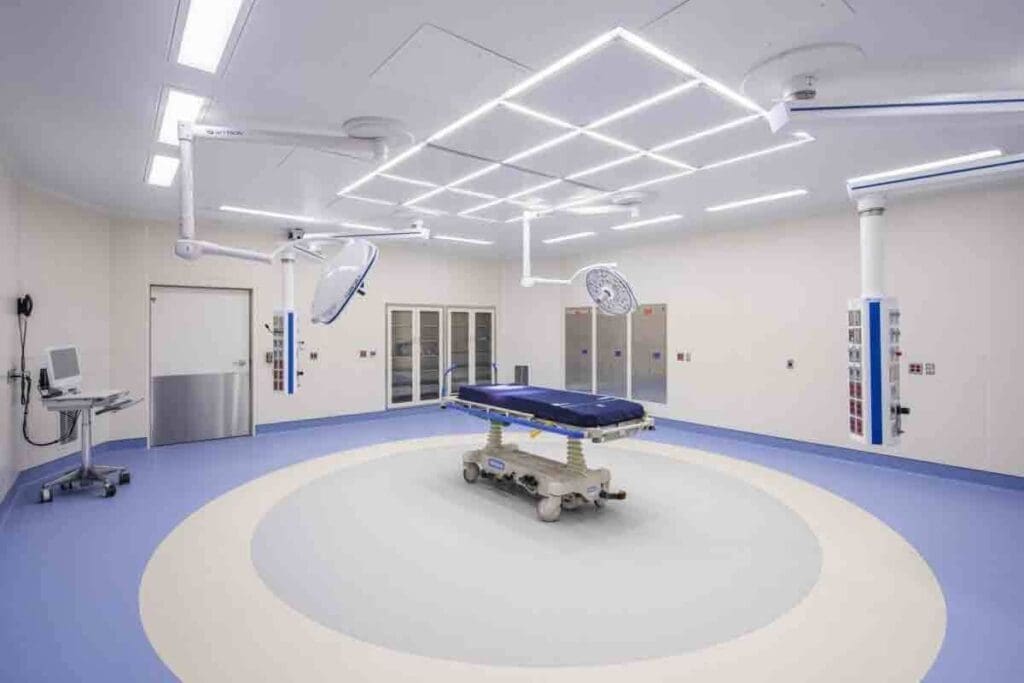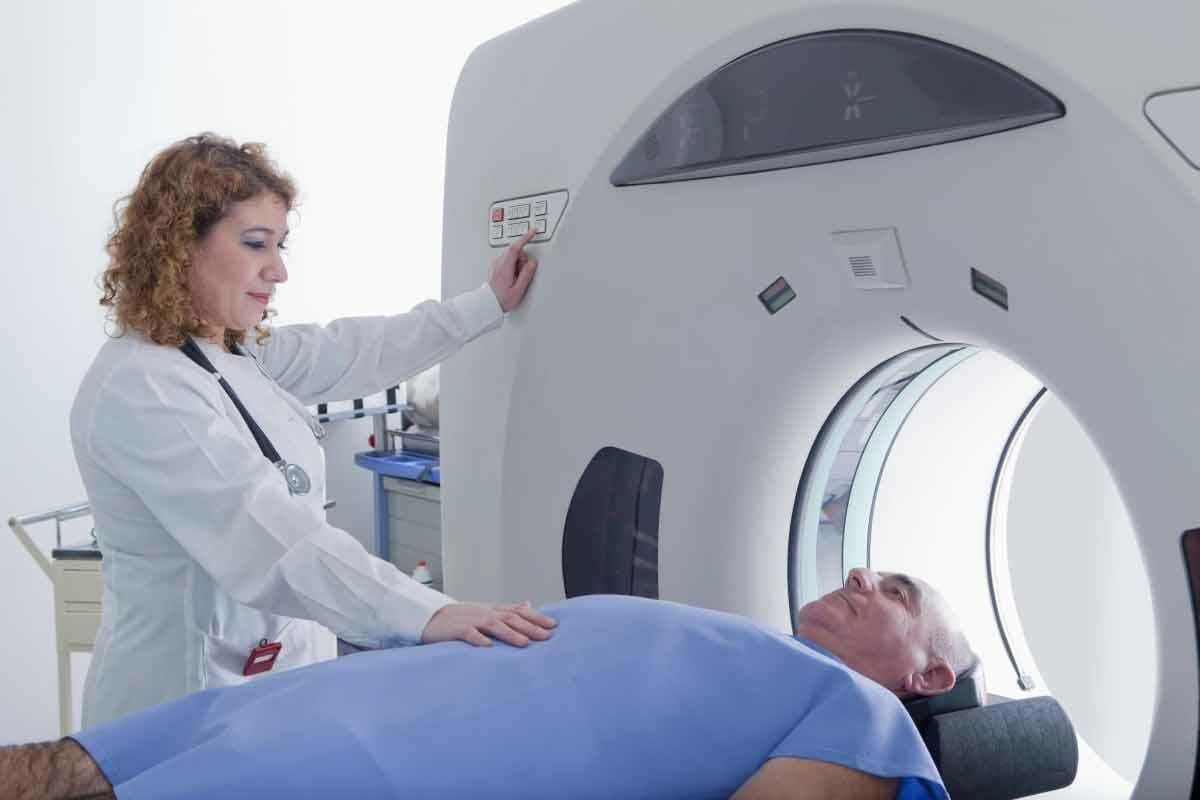Last Updated on November 27, 2025 by Bilal Hasdemir

The full-body PET scanner is a big step forward in molecular imaging. It lets us see the whole body in one go. This is a huge leap in how we diagnose diseases.
The Quadra PET/CT scanner at BC Cancer – Vancouver is a great example. It can scan from head to pelvis in just one frame. This shows how full-body PET CT scans are changing the game in medical care.
Looking into full-body PET CT scans, we see they’re setting new highs in medical imaging. They’re making a big difference in how we diagnose and treat patients.
Key Takeaways
- Full body PET scanners enable complete whole body imaging in one scan.
- The technology offers fast and precise diagnostic abilities.
- Advanced scanners like the Quadra PET/CT scan from head to pelvis in one frame.
- This technology is changing the way we approach patient care.
- Whole body PET CT scans are becoming essential in modern medical imaging.
The Revolutionary Impact of Full-Body PET Scanners on Medical Imaging

Full-body PET scanners have changed medical imaging a lot. They give doctors new ways to find and treat diseases. This is thanks to the advanced tech of full-body PET scanners.
From Conventional PET CT to Total Body Imaging
The move to total body imaging is a big deal. Old PET CT scanners could only look at parts of the body at a time. They needed many scans and took longer.
Now, full-body PET scanners like the uEXPLORER can see the whole body in one scan. They have a 194 cm field of view. This means better accuracy and less discomfort for patients.
Key Technological Advancements in Modern PET Imaging
Modern PET imaging has brought big tech changes. One key one is PET TAC total body technology. It lets doctors see from head to pelvis in one scan. The Quadra PET/CT scanner is an example, giving fast and full-body scans.
| Technological Advancement | Benefit |
| PET TAC total body technology | Comprehensive imaging in a single scan |
| Maximum Resolution Imaging | Enhanced diagnostic accuracy |
| Whole Body PET CT | Reduced scan times and improved patient experience |
These new technologies are changing medical imaging a lot. They help doctors find and treat diseases better. With more maximum resolution imaging and tech, we’ll see even more progress in caring for patients.
How Full Body PET Scanner Technology Transforms Diagnostic Capabilities

Full-body PET scanner technology has changed how we do medical imaging. It has made a big difference in how we do diagnostic tests. Modern full-body PET scan machines have advanced features.
These machines are a big step forward in medical tech. They offer better sensitivity, faster scans, and clearer images. Digital PET detectors in these scanners have made imaging more accurate and detailed.
The 40x Sensitivity Increase: Clinical Significance
New PET scanners, like the Quadra PET/CT, are 40 times more sensitive than old ones. This means they can spot small problems that were hard to find before. It’s a big deal for early disease detection and treatment.
With PET scan whole body tech, doctors can see the whole body in one scan. This is really helpful in cancer care. It helps find cancer spread and check how treatments are working.
Reduced Scan Times and Improved Patient Experience
Modern PET scanners also scan faster. The Quadra PET/CT scanner scans much quickly than old models. This makes things run smoothly and makes patients happier.
The pet whole body scan tech also makes things easier for patients. They can be scanned from head to toe without moving much. This makes the whole process less scary and uncomfortable.
| Feature | Traditional PET/CT | Modern Full Body PET/CT |
| Sensitivity | 1x | 40x |
| Scan Time | Longer | Significantly Reduced |
| Image Quality | Good | Excellent |
| Patient Experience | Variable | Enhanced |
| Technology | Conventional Detectors | Digital PET Detectors |
| Scan Type | Limited Coverage | PET CT scan whole body |
PET TAC Total Body Technology: The Science Behind the Breakthrough
PET TAC total body technology has changed medical imaging a lot. It lets us see the whole body in one scan. This has made diagnosing diseases much better.
Core Components of Advanced PET TAC Systems
Core Components
The Quadra PET/CT scanner is a key example of PET TAC technology. It combines PET and CT scans to look at organs and tissues at a molecular level. Its advanced parts include:
- Advanced PET detectors that give high sensitivity and detail.
- State-of-the-art CT technology for detailed body images.
- Sophisticated software that mixes PET and CT data for full images.
Integration with CT for Comprehensive Imaging
PET and CT technologies together in PET TAC systems help doctors diagnose better. They combine PET’s functional info with CT’s body details. This gives a clearer picture of the body’s health.
This detailed imaging is great for cancer, brain, and heart health. It spots small problems that other scans miss.
PET TAC technology gives us a full view of the body. It helps us find and treat diseases more accurately.
Digital PET Detectors: The Heart of Whole Body PET CT Systems
At the heart of modern whole-body PET CT systems is a cutting-edge technology: digital PET detectors. These advanced detectors are key to getting high-quality images in PET scans.
Integrated-Light-Guide Silicon Photomultipliers (SiPMs)
Integrated-Light-Guide Silicon Photomultipliers (SiPMs) are a major part of digital PET detectors. SiPMs beat traditional PET detectors in sensitivity and speed. They work better with light guides to catch more photons, making images clearer.
SiPMs bring several benefits:
- They’re super sensitive to photons.
- They process signals quickly.
- They help make images more detailed.
How Digital Detection Improves PET Resolution
Digital PET detectors make PET scans better by giving clearer images. They help doctors see small problems more easily. This is key to spotting and tracking diseases.
The good things about digital detection in PET scans are:
- Clearer images: Digital detectors make pictures sharper, helping spot small issues.
- More accurate diagnosis: With clearer images, doctors can make better diagnoses and plans.
- Accurate tracking: Digital detectors let doctors track how diseases progress and how treatments work.
Using digital PET detectors, whole body PET CT systems can get top-notch images. This leads to better care for patients.
Maximum Resolution Imaging: Achieving 2.9mm Ultra-High Spatial Resolution
PET scanner technology has made huge leaps, leading to ultra-high spatial resolution. This change has greatly improved how we can see inside the body. It makes it easier to find and diagnose diseases accurately.
The Technical Standards of PET Scan Resolution
PET scan resolution has grown thanks to better detectors and image algorithms. Modern scanners, like the Quadra PET/CT, show cancer and diseases in more detail. This helps doctors see what’s going on inside the body more clearly.
Key technical advancements include digital PET detectors and advanced algorithms. These improvements make images clearer and more detailed.
Clinical Impact of Enhanced Spatial Resolution
Having a 2.9mm ultra-high spatial resolution in PET imaging changes how we treat patients. It lets doctors spot smaller problems and understand how far a disease has spread. This information is key to planning the best treatment.
For example, the uEXPLORER offers ultra-high spatial resolution PET scan resolution. This means doctors can catch tiny issues that might be missed with less detailed scans.
The 194cm Axial Field of View: Complete Anatomical Coverage in One Scan
The uEXPLORER PET/CT scanner has a 194cm axial field of view. This is a big step forward in whole-body imaging. It lets doctors get detailed images of the whole body in just one scan. This makes diagnosis more accurate and is better for patients.
Benefits of Extended Field of View in Full Body PET CT
The uEXPLORER’s wide field of view brings many benefits. It covers the whole body in one scan. This means fewer scans and less time for patients.
It’s great for cancer staging, where seeing how far the disease has spread is key. The wide view also helps spot small problems that might be missed by narrower scans.
Simultaneous Multi-Organ Imaging Capabilities
Full body PET CT lets doctors see the whole body at once. This means they can check many organs and tissues together. It gives a complete picture of a patient’s health.
In cancer care, it’s a game-changer. Doctors can see tumors, where they’ve spread, and the patient’s overall health in one go. This info is essential for planning treatment and tracking how well it’s working.
The Quadra PET/CT scanner, also in Canada, has the biggest field of view. It shows how fast whole body PET CT is getting better.
These new tools are changing medical imaging. They help doctors make better diagnoses and treatment plans. We’re excited to keep improving with full-body PET CT. Our goal is to make care better and outcomes better for patients.
Enhanced Detection of Subtle Lesions with Whole Body PET Scan Technology
Whole body PET scan technology greatly improves the ability to find small lesions. It gives doctors important information for diagnosis. This is key to catching diseases early and treating them effectively.
The Quadra PET/CT scanner is a top example of this tech. It finds cancer early and uses less radiation. Its advanced detectors and wide view allow for detailed scans in one go.
Identifying Previously Undetectable Abnormalities
Whole body PET scans can spot issues that were missed before. This is very important in cancer care. Finding cancer early can really help patients.
Key benefits include:
- Improved detection of small lesions
- Enhanced image resolution
- Better differentiation between malignant and benign tissues
Clinical Applications in Oncology, Neurology, and Cardiology
Whole-body PET scans are used in many fields. In cancer, they help find and stage tumors. In brain disorders, they help diagnose and track. In heart health, they check how well the heart works.
The NeuroExplorer, a cutting-edge PET scanner, exemplifies its use in neurological applications. Its advanced design and capabilities make it a valuable tool for researchers and doctors.
The use of U-Tracer in PET scans makes the diagnosis clearer. It shows how the body’s cells are working. This helps track disease progress and treatment success.
Ultra-Low Dose Protocols: Safer Full Body PET CT Scanning
New PET CT scanning methods now offer safer imaging with ultra-low dose protocols. This change makes full-body PET CT scans more accessible and safer for more patients.
Radiation Exposure Reduction in Modern Systems
Modern full-body PET CT scanners, like the Quadra PET/CT scanner, use technology for ultra-low dose protocols. This reduces radiation exposure for patients. It’s key for lowering risks, mainly for those needing repeated scans or long-term monitoring.
Recent studies show that the new PET/CT scanners cut radiation doses a lot. For example, a study on PMC shows these systems can do low-dose imaging well without losing quality.
| Feature | Conventional PET/CT | Modern PET/CT with Ultra-Low Dose |
| Radiation Exposure | Higher doses | Significantly reduced doses |
| Scan Time | Longer scan times | Faster scan times |
| Image Quality | Standard resolution | High resolution |
Pediatric and Radiation-Sensitive Applications
Ultra-low dose protocols are great for kids and those who are more sensitive to radiation. They lower the risk of long-term side effects. This makes PET CT scanning safer for these groups.
Full body PET CT supports ultra-low dose protocols. It’s a top choice for a wider range of patients. This is a big step in our goal to provide top-notch healthcare worldwide.
Conclusion: The Future of Full Body PET Imaging in Modern Medicine
Full-body PET imaging is changing how we diagnose diseases. The full-body pet scanner has made it easier for doctors to give better care. This technology is a big step forward in medical diagnostics.
The whole body PET CT technology brings new levels of detail to diagnoses. The PET Tac total body method makes PET scans more sensitive. This means doctors can spot small problems that were hard to find before.
Liv Hospital aims to offer top-notch medical care. Next-generation PET/CT scanners will lead to new discoveries in cancer treatment and other areas. As this tech gets better, we’ll see better patient results and more medical breakthroughs.
The future of full-body PET imaging looks very promising. With ongoing improvements, we’ll keep getting better at diagnosing diseases. Our goal is to provide the best healthcare possible for our patients.
FAQ
What is a full-body PET scanner, and how does it differ from conventional PET CT scanners?
A full-body PET scanner captures detailed images of the whole body in one scan. This is different from conventional PET CT scanners, which have a limited view. It offers complete body imaging, improving diagnosis and patient care.
What are the benefits of maximum resolution imaging in full-body PET CT scans?
Maximum resolution imaging in full-body PET CT scans helps spot small lesions and abnormalities. This is key for accurate diagnoses and treatment plans in fields like oncology, neurology, and cardiology.
How does PET TAC total body technology integrate with CT for comprehensive imaging?
PET TAC total body technology combines PET and CT for detailed images. It shows both the body’s structure and function. This helps doctors make better diagnoses and treatment plans.
What role do digital PET detectors play in whole body PET CT systems?
Digital PET detectors, like those with Integrated-Light-Guide Silicon Photomultipliers (SiPMs), are key in whole body PET CT systems. They boost PET resolution by better detecting gamma rays. This leads to clearer images and more accurate diagnoses.
What are the advantages of an extended axial field of view in full-body PET CT scans?
An extended axial field of view, like 194cm, covers the whole body in one scan. It allows for imaging of multiple organs at once. This makes diagnosis faster, reduces scan times, and improves patient comfort.
How do ultra-low dose protocols impact full-body PET CT scanning?
Ultra-low dose protocols make full-body PET CT scans safer by reducing radiation. This is great for kids and people sensitive to radiation. It keeps the scan safe while keeping image quality and accuracy high.
What is the significance of achieving ultra-high spatial resolution in PET scan technology?
Ultra-high spatial resolution, like 2.9mm, in PET scan technology, is a big step forward. It lets doctors spot smaller lesions and understand abnormalities better. This leads to more accurate diagnoses and better treatment outcomes.
How does whole-body PET scan technology enhance the detection of subtle lesions?
Whole body PET scan technology improves the detection of small lesions by providing detailed images of the whole body. This is very useful in oncology, neurology, and cardiology. Early detection and accurate characterization of lesions are key to effective treatment.
What are the clinical applications of full-body PET CT scans in various medical specialties?
Full-body PET CT scans have many uses in fields like oncology, neurology, and cardiology. They help stage cancer, assess neurological disorders, and evaluate cardiac conditions. They provide valuable information for treatment decisions.
How does the U tracer contribute to the effectiveness of full-body PET CT scans?
The U tracer is essential in PET CT scans. It helps visualize and assess metabolic processes in the body. By using specific tracers, doctors can gain insights into various physiological and pathological processes. This enhances diagnostic accuracy and treatment planning.
What is the role of NeuroExplorer in the context of full-body PET CT scans?
Neuroexplorer refers to advanced imaging techniques for neurological conditions. In full body PET CT scans, it enhances the assessment of neurological disorders. It provides detailed images of brain function and structure, aiding in accurate diagnoses and treatment plans.
How does the pet detector technology impact the quality of full-body PET CT scans?
Pet detector technology, like digital PET detectors, greatly affects the quality of full-body PET CT scans. It improves image resolution and sensitivity. Advanced detector technologies enhance gamma ray detection, leading to higher-quality images for accurate diagnoses and treatment planning.
References
- Hu, Z., et al. (2024). Performance and application of the total-body PET/CT scanner: a comprehensive review. Frontiers in Medicine, 11, 11014840. https://www.ncbi.nlm.nih.gov/pmc/articles/PMC11014840/






